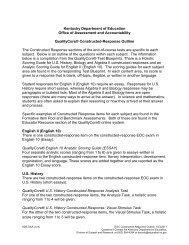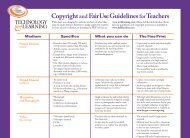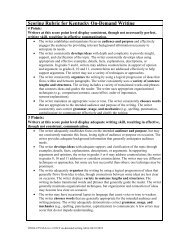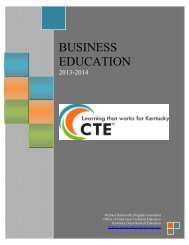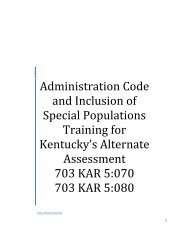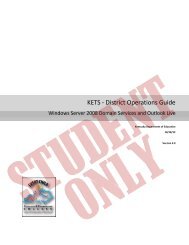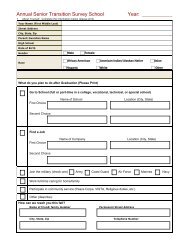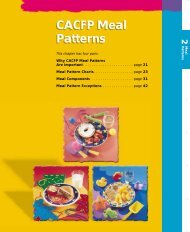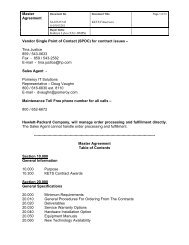Standards with Progressions grades K-HS v. 1.3 - Kentucky ...
Standards with Progressions grades K-HS v. 1.3 - Kentucky ...
Standards with Progressions grades K-HS v. 1.3 - Kentucky ...
- No tags were found...
You also want an ePaper? Increase the reach of your titles
YUMPU automatically turns print PDFs into web optimized ePapers that Google loves.
Geometry<br />
Grade 6 Grade 7 Grade 8<br />
Solve real-world and mathematical problems involving area,<br />
surface area, and volume.<br />
Draw, construct, and describe geometrical figures and describe<br />
the relationships between them.<br />
6.G.1: Find the area of right triangles, other triangles,<br />
special quadrilaterals, and polygons by composing<br />
into rectangles or decomposing into triangles and<br />
other shapes; apply these techniques in the<br />
7.G.1: Solve problems involving scale drawings of<br />
geometric figures, including computing actual<br />
lengths and areas from a scale drawing and<br />
reproducing a scale drawing at a different scale.<br />
context of solving real-world and mathematical<br />
problems.<br />
7.G.2: Draw (freehand, <strong>with</strong> ruler and protractor, and <strong>with</strong><br />
technology) geometric shapes <strong>with</strong> given conditions.<br />
6.G.2: Find the volume of a right rectangular prism <strong>with</strong><br />
fractional edge lengths by packing it <strong>with</strong> unit<br />
cubes of the appropriate unit fraction edge<br />
lengths, and show that the volume is the same as<br />
Focus on constructing triangles from three measures<br />
of angles or sides, noticing when the conditions<br />
determine a unique triangle, more than one triangle,<br />
or no triangle.<br />
would be found by multiplying the edge lengths of<br />
the prism. Apply the formulas V = l w h and V = b h<br />
to find volumes of right rectangular prisms <strong>with</strong><br />
fractional edge lengths in the context of solving<br />
7.G.3: Describe the two-dimensional figures that result<br />
from slicing three-dimensional figures, as in plane<br />
sections of right rectangular prisms and right<br />
rectangular pyramids.<br />
real-world and mathematical problems.<br />
Solve real-life and mathematical problems involving angle<br />
6.G.3: Draw polygons in the coordinate plane given measure, area, surface area, and volume.<br />
coordinates for the vertices; use coordinates to<br />
find the length of a side joining points <strong>with</strong> the<br />
same first coordinate or the same second<br />
coordinate. Apply these techniques in the context<br />
7.G.4: Know the formulas for the area and circumference<br />
of a circle and use them to solve problems; give an<br />
informal derivation of the relationship between the<br />
circumference and area of a circle.<br />
of solving real-world and mathematical problems. 7.G.5: Use facts about supplementary, complementary,<br />
6.G.4: Represent three-dimensional figures using nets<br />
made up of rectangles and triangles, and use the<br />
nets to find the surface area of these figures.<br />
vertical, and adjacent angles in a multi-step problem<br />
to write and solve simple equations for an unknown<br />
angle in a figure.<br />
Apply these techniques in the context of solving<br />
real-world and mathematical problems.<br />
7.G.6: Solve real-world and mathematical problems<br />
involving area, volume and surface area of two- and<br />
three-dimensional objects composed of triangles,<br />
quadrilaterals, polygons, cubes, and right prisms.<br />
Understand congruence and similarity using physical models, transparencies, or<br />
geometry software.<br />
8.G.1: Verify experimentally the properties of rotations, reflections, and<br />
translations:<br />
a. Lines are taken to lines, and line segments to line segments of the<br />
same length.<br />
b. Angles are taken to angles of the same measure.<br />
c. Parallel lines are taken to parallel lines.<br />
8.G.2: Understand that a two-dimensional figure is congruent to another if the<br />
second can be obtained from the first by a sequence of rotations,<br />
reflections, and translations; given two congruent figures, describe a<br />
sequence that exhibits the congruence between them.<br />
8.G.3: Describe the effect of dilations, translations, rotations, and reflections<br />
on two-dimensional figures using coordinates.<br />
8.G.4: Understand that a two-dimensional figure is similar to another if the<br />
second can be obtained from the first by a sequence of rotations,<br />
reflections, translations, and dilations; given two similar twodimensional<br />
figures, describe a sequence that exhibits the similarity<br />
between them.<br />
8.G.5: Use informal arguments to establish facts about the angle sum and<br />
exterior angle of triangles, about the angles created when parallel lines<br />
are cut by a transversal, and the angle-angle criterion for similarity of<br />
triangles. For example, arrange three copies of the same triangle so that<br />
the sum of the three angles appears to form a line, and give an argument<br />
in terms of transversals why this is so.<br />
Understand and apply the Pythagorean Theorem.<br />
8.G.6: Explain a proof of the Pythagorean Theorem and its converse.<br />
8.G.7: Apply the Pythagorean Theorem to determine unknown side lengths in<br />
right triangles in real-world and mathematical problems in two and<br />
three dimensions.<br />
8.G.8: Apply the Pythagorean Theorem to find the distance between two<br />
points in a coordinate system.<br />
Solve real-world and mathematical problems involving volume of cylinders, cones,<br />
and spheres.<br />
8.G.9: Know the formulas for the volumes of cones, cylinders, and spheres and<br />
use them to solve real-world and mathematical problems.<br />
<strong>Kentucky</strong> Department of Education<br />
39 | P a g e




